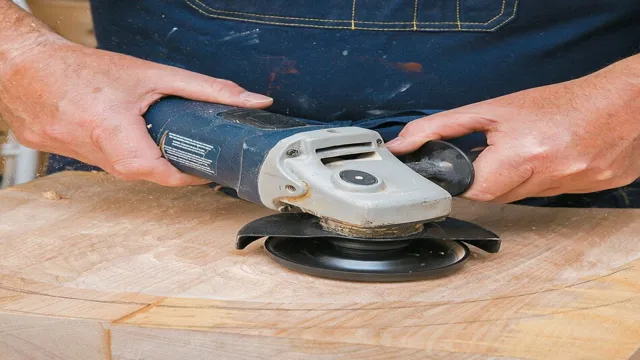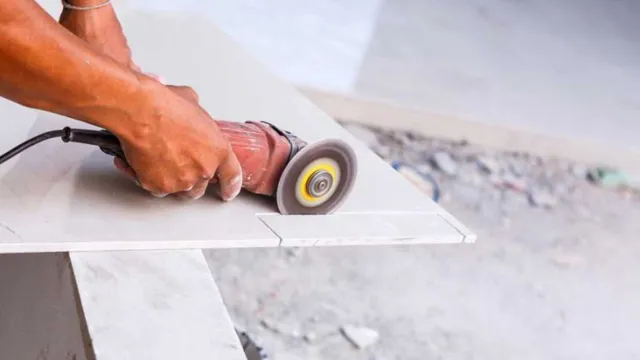Can You Use an Angle Grinder on Wood? A Beginner’s Guide to Grinding Wood with an Angle Grinder.

Have you ever wondered if an angle grinder can be used on wood? The answer is yes, and the possibilities are endless! If you’re familiar with this powerful tool, you may have used it for cutting, grinding, and polishing metal or concrete. But did you know that an angle grinder can also be utilized for shaping, sanding, and even carving wood? With the right attachment and blade, an angle grinder can transform a block of wood into a beautifully sculpted piece of art or a sleek piece of furniture. However, using an angle grinder on wood requires care and attention, as this tool can be dangerous when not handled properly.
In this blog, we’ll explore the possibilities of using an angle grinder on wood, discuss the various attachments and blades you’ll need, and provide safety tips to ensure you can achieve the desired results without harm. So, let’s grab our angle grinders and get to work!
Understanding Angle Grinders
If you’re wondering if you can use an angle grinder on wood, the answer is yes! While angle grinders are typically used for cutting and grinding metal, they can also be used for woodwork. However, it’s important to ensure you have the right attachments and wheels. Use a diamond-tipped blade or flap disc to prevent overheating and causing a fire.
Additionally, when using an angle grinder on wood, it’s important to take safety precautions such as wearing goggles and a dust mask, and avoiding putting too much pressure on the wood to prevent kickback. Remember to take care when using any power tool and always follow the manufacturer’s instructions.
What is an Angle Grinder?
An angle grinder is a versatile power tool that can be used for grinding, cutting, polishing, and sanding materials such as metal, concrete, and wood. It consists of a motor that drives a spinning abrasive disc or wheel, which can be adjusted for different tasks with the use of different discs. Understanding how to use an angle grinder properly is crucial for safety and effective use.
It is important to wear personal protective equipment such as gloves, goggles, and a hearing protection device, as angle grinders can produce a lot of noise and sparks. It is also essential to choose the right type of abrasive disc for the task at hand, as well as to ensure that the disc is securely fastened to the tool’s spindle before use. Angle grinders can be a valuable addition to a DIY toolkit, but it is vital to use them with caution to avoid accidents and injuries.

What are the Common Uses of an Angle Grinder?
Angle grinders are versatile tools that can be used for a wide variety of applications. They are commonly used for grinding, cutting, and polishing materials such as metal, wood, and concrete. Angle grinders are also used for removing rust and old paint, cutting tiles and pavers, and sharpening blades.
They come in different sizes and power ratings which make them perfect for different applications. For instance, a 5-inch angle grinder is ideal for home use and light-duty tasks while a larger angle grinder with a 9-inch blade is suitable for professional use and heavy-duty jobs.
The power source of an angle grinder can either be electric, battery-powered, or pneumatic. Understanding the different uses of angle grinders will help you choose the right tool for your specific needs. Overall, angle grinders are handy tools to have in your toolkit as they can help you handle a variety of DIY projects with ease.
Grinding Wood with an Angle Grinder
Yes, you can certainly use an angle grinder on wood! While angle grinders are typically used for metalworking tasks like cutting and grinding steel or removing rust, they can also be great for shaping and sanding wood. In fact, using an angle grinder can help you quickly remove rough spots or jagged edges from a piece of wood, leaving behind a smooth and even surface. To use an angle grinder on wood, you’ll need to attach a sanding disc or flap disc to the tool.
These attachments are specifically designed for woodworking tasks and are much gentler on wood than metal-cutting discs. It’s also important to wear eye protection and work gloves to keep yourself safe while using an angle grinder on wood. Overall, an angle grinder can be a versatile tool for both metalworking and woodworking tasks, making it a great addition to any DIYer’s toolkit.
Can You Use an Angle Grinder on Wood?
Angle Grinder on Wood Angle grinders may be commonly associated with metalworking, but they can also be used for grinding wood. With the right attachment, such as a carving disc or flap wheel, an angle grinder can be a powerful tool for shaping and smoothing wood. However, it’s important to note that using an angle grinder on wood can be dangerous if not done properly.
The high speed and aggressive nature of the tool can easily cause damage or injury if the user is not careful. It’s crucial to wear protective gear, including safety glasses and a dust mask, and to securely clamp the wood down to a work surface. Additionally, using small, controlled movements and taking breaks to let the tool cool down can help prevent any accidents.
Overall, an angle grinder can be an effective and efficient way to work with wood, but it’s essential to use caution and proper technique.
Techniques for Grinding Wood with an Angle Grinder
Grinding wood with an angle grinder can seem overwhelming, but with the right techniques, it can be done successfully. The first step is to choose the correct grinder wheel for the job. A carbide carving wheel is best for shaping and removing material quickly, whereas flap discs are better suited for smoothing and finishing.
To begin, secure the wood firmly in place with a clamp or vice and wear protective gear, including goggles and a dust mask. Keep the angle grinder at a 30-degree angle for best results and work in small sections, moving the grinder back and forth in a smooth motion. Make sure to keep the grinder moving to avoid creating grooves or dents.
Finishing the wood with sandpaper after grinding will give it a smoother finish. Remember, practice makes perfect, and with some patience and persistence, grinding wood with an angle grinder can be a rewarding task for any DIYer.
Safety Precautions to Take When Grinding Wood with an Angle Grinder
If you’re looking to grind wood with an angle grinder, it’s important to take a few safety precautions to avoid any accidents. First and foremost, make sure you’re wearing protective gear, including safety goggles, gloves, and a dust mask. This will protect your eyes, hands, and lungs from any flying debris or sawdust.
Secondly, be sure to secure the piece of wood you’re grinding firmly in place to prevent it from moving or shifting during the grinding process. It’s also a good idea to use a clamp or vise to hold it in place. Lastly, be aware of your surroundings, and make sure the area around you is clear of any potential hazards.
Keep your angle grinder at a steady pace, and avoid applying too much pressure to prevent any kickback that could injure you. By following these simple safety measures, you can safely and efficiently grind wood with an angle grinder without any harm.
Alternatives to Using an Angle Grinder on Wood
If you’re wondering whether or not you can use an angle grinder on wood, the answer is yes! However, using an angle grinder on wood can lead to rough and uneven cuts, leaving you with a lot of sanding and finishing to do. An alternative to using an angle grinder on wood is to use a saw or jigsaw with a fine blade. This will result in smoother and more precise cuts.
Another alternative is to use a rotary tool with various attachments for sanding, carving, or cutting. This allows for more intricate and detailed work on the wood. So, while an angle grinder can be used on wood, there are more efficient and effective tools available specifically for woodworking.
Other Tools You Can Use to Work with Wood
While an angle grinder is a versatile tool for working with wood, there are alternatives you can use that can provide you with different results. For instance, a rotary tool can be an excellent option for creating intricate details or for sanding in tight and difficult-to-reach areas. A jigsaw can help you cut curves or shapes, and a circular saw is ideal for straight cuts.
Meanwhile, a hand plane can help you smooth out rough surfaces and adjust thickness, providing you with an even finish. Ultimately, the tool you choose will depend on the kind of task you have at hand and your proficiency with each tool. By trying out different alternatives and finding which ones work best for you, you can create beautiful, high-quality woodwork with ease.
Which Tool Should You Use for Your Project?
When it comes to working with wood, an angle grinder may not always be the best tool to use. Alternatives include a jigsaw, circular saw, or even a hand saw, depending on the project. A jigsaw can make curved cuts and intricate designs, while a circular saw is better suited for long, straight cuts.
If you’re looking for a more traditional approach, a hand saw can still get the job done with precision and control. It’s important to choose the right tool for the job to ensure a successful project, and considering alternatives to the angle grinder can help you achieve the desired results.
Conclusion
In conclusion, while using an angle grinder on wood may seem odd or counterintuitive at first, it is actually a versatile and resourceful method for shaping and carving wood with precision and speed. So go ahead, grab your angle grinder and unleash your inner carpenter – just be sure to take proper safety precautions and remember that with great power comes great responsibility (and maybe some sawdust in your hair). Happy grinding!”
FAQs
What is an angle grinder and what is it used for?
An angle grinder is a handheld power tool used for cutting, grinding, and polishing various materials, including wood.
Can I use an angle grinder on wood?
Yes, an angle grinder can be used on wood, but you need to use the appropriate attachments and follow safety precautions.
What kind of attachment should I use for an angle grinder on wood?
For wood, it is recommended to use a flap disc or sanding disc attachment on your angle grinder.
What safety precautions do I need to take when using an angle grinder on wood?
Always wear eye and ear protection, gloves, and a dust mask. Make sure the wood is securely clamped down before grinding, and keep a fire extinguisher nearby in case sparks ignite any sawdust.
Can I use an angle grinder to cut wooden boards?
Yes, you can use an angle grinder to make cuts in wooden boards, but it is recommended to use a circular saw instead for more precision and control.
What type of wood is suitable for grinding with an angle grinder?
Any type of wood can be ground with an angle grinder, but harder woods like oak or maple may take longer to grind down.
How do I maintain my angle grinder after using it on wood?
After using your angle grinder on wood, make sure to clean it thoroughly with a wire brush to remove any sawdust or debris. Lubricate the moving parts, and store it in a dry place.



